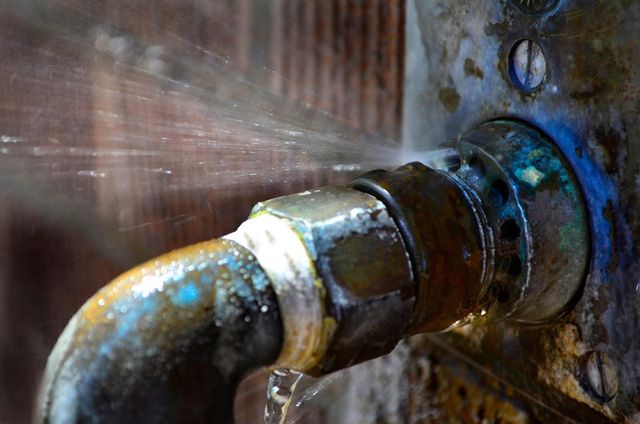Just how do you feel in regards to Why Do My Plumbing Pipes Make A Knocking Noise?
:no_upscale()/cdn.vox-cdn.com/uploads/chorus_image/image/66274734/Plumbing_0519-Brookline-P1010292--Mike-Last.0.0.jpg)
To identify loud plumbing, it is important to identify very first whether the unwanted audios take place on the system's inlet side-in various other words, when water is transformed on-or on the drain side. Sounds on the inlet side have actually differed causes: excessive water pressure, used shutoff and tap parts, improperly attached pumps or various other appliances, improperly positioned pipeline bolts, and also plumbing runs including a lot of limited bends or various other restrictions. Sounds on the drainpipe side usually originate from poor place or, similar to some inlet side noise, a format having limited bends.
Hissing
Hissing noise that takes place when a faucet is opened slightly typically signals too much water pressure. Consult your regional water company if you think this issue; it will certainly have the ability to tell you the water pressure in your location and also can set up a pressurereducing valve on the incoming water supply pipeline if needed.
Thudding
Thudding noise, frequently accompanied by shuddering pipelines, when a tap or home appliance shutoff is shut off is a condition called water hammer. The sound and vibration are triggered by the reverberating wave of pressure in the water, which instantly has no area to go. In some cases opening a shutoff that releases water promptly into an area of piping containing a constraint, arm joint, or tee fitting can create the exact same problem.
Water hammer can usually be treated by mounting installations called air chambers or shock absorbers in the plumbing to which the trouble valves or taps are linked. These gadgets enable the shock wave developed by the halted circulation of water to dissipate airborne they have, which (unlike water) is compressible.
Older plumbing systems might have brief vertical sections of capped pipe behind walls on faucet competes the same function; these can ultimately fill with water, reducing or damaging their efficiency. The remedy is to drain pipes the water system entirely by shutting down the main water supply shutoff and also opening up all taps. After that open the main supply shutoff as well as close the taps individually, beginning with the tap nearest the valve as well as finishing with the one farthest away.
Chattering or Shrieking
Intense chattering or screeching that occurs when a valve or faucet is switched on, and that usually disappears when the fitting is opened fully, signals loose or malfunctioning inner parts. The option is to change the shutoff or faucet with a new one.
Pumps and home appliances such as washing equipments and dish washers can move motor noise to pipes if they are improperly attached. Link such products to plumbing with plastic or rubber hoses-never rigid pipe-to isolate them.
Various Other Inlet Side Noises
Squeaking, squeaking, damaging, breaking, and also touching generally are triggered by the growth or contraction of pipelines, usually copper ones providing warm water. The audios occur as the pipes slide against loose fasteners or strike nearby home framework. You can typically identify the location of the issue if the pipelines are revealed; just comply with the sound when the pipelines are making sounds. Probably you will find a loosened pipeline wall mount or a location where pipes exist so close to flooring joists or various other mounting items that they clatter against them. Attaching foam pipeline insulation around the pipelines at the point of contact need to fix the problem. Make sure straps and wall mounts are safe and secure and also supply ample assistance. Where feasible, pipe bolts need to be attached to huge architectural aspects such as foundation wall surfaces as opposed to to mounting; doing so minimizes the transmission of vibrations from plumbing to surfaces that can enhance and also move them. If connecting fasteners to framework is inescapable, wrap pipes with insulation or various other durable product where they contact bolts, and also sandwich the ends of brand-new fasteners between rubber washing machines when mounting them.
Fixing plumbing runs that struggle with flow-restricting limited or countless bends is a last resource that should be embarked on just after speaking with a proficient plumbing specialist. Unfortunately, this scenario is rather usual in older homes that might not have been developed with indoor plumbing or that have seen several remodels, especially by novices.
Drainpipe Noise
On the drainpipe side of plumbing, the chief objectives are to remove surfaces that can be struck by dropping or rushing water and to protect pipes to include inescapable noises.
In brand-new construction, bath tubs, shower stalls, bathrooms, and also wallmounted sinks and containers must be set on or versus resistant underlayments to minimize the transmission of sound through them. Water-saving commodes and also taps are less loud than conventional versions; mount them rather than older kinds even if codes in your location still allow utilizing older components.
Drainpipes that do not run vertically to the basement or that branch right into straight pipeline runs supported at floor joists or various other framing present particularly problematic noise troubles. Such pipes are huge sufficient to radiate significant resonance; they also bring substantial quantities of water, which makes the situation even worse. In brand-new construction, define cast-iron soil pipes (the big pipes that drain pipes toilets) if you can afford them. Their massiveness includes much of the noise made by water passing through them. Also, stay clear of routing drainpipes in walls shared with bed rooms and also areas where individuals collect. Walls having drains need to be soundproofed as was described earlier, making use of dual panels of sound-insulating fiber board and wallboard. Pipes themselves can be wrapped with unique fiberglass insulation produced the function; such pipes have a resistant plastic skin (sometimes containing lead). Results are not always satisfactory.
3 Most Common Reasons for Noisy Water Pipes
Water hammer
When water is running and is then suddenly turned off, the rushing liquid has no place to go and slams against the shut-off valve. The loud, thudding sound that follows is known as a water hammer. Besides being alarming, water hammer can potentially damage joints and connections in the water pipe itself. There are two primary methods of addressing this issue.
Check your air chamber. An air chamber is essentially a vertical pipe located near your faucet, often in the wall cavity that holds the plumbing connected to your sink or tub. The chamber is filled with air that compresses and absorbs the shock of the fast moving water when it suddenly stops. Unfortunately, over time air chambers tend to fill with water and lose their effectiveness. To replenish the air chambers in your house you can do the following. Turn off the water supply to your house at the main supply (or street level). Open your faucets to drain all of the water from your plumbing system. Turn the water back on. The incoming water will flush the air out of the pipes but not out of the vertical air chamber, where the air supply has been restored. Copper pipes
Copper pipes tend to expand as hot water passes through and transfers some of its heat to them. (Copper is both malleable and ductile.) In tight quarters, copper hot-water lines can expand and then noisily rub against your home's hidden structural features — studs, joists, support brackets, etc. — as it contracts.
One possible solution to this problem is to slightly lower the temperature setting on your hot water heater. In all but the most extreme cases, expanding and contracting copper pipes will not spring a leak. Unless you’re remodeling, there's no reason to remove sheetrock and insert foam padding around your copper pipes.
Water pressure that’s too high
If your water pressure is too high, it can also cause noisy water pipes. Worse, high water pressure can damage water-supplied appliances, such as your washing machine and dishwasher.
Most modern homes are equipped with a pressure regulator that's mounted where the water supply enters the house. If your home lacks a regulator, consider having one professionally installed. Finally, remember that most plumbers recommend that water is delivered throughout your home at no lower than 40 and no greater than 80 psi (pounds per square inch).
Whatever the state of your plumbing, one thing is certain — you’re eventually going to encounter repair and replacement issues around your home that require professional help. That’s where American Home Shield can come to your aid.
https://www.ahs.com/home-matters/repair-maintenance/causes-of-noisy-water-pipes/

Do you appreciate reading up on Why is My Home Making Strange Plumbing Noises? Place a remark below. We will be interested to hear your opinions about this blog entry. Hoping that you come back again soon. Sharing is nice. You never know, you might be doing someone a favor. We treasure reading our article about How To Fix Noisy Pipes.
Choose our certified emergency plumbers.
 Ben Savage Then & Now!
Ben Savage Then & Now! Marla Sokoloff Then & Now!
Marla Sokoloff Then & Now! Bill Cosby Then & Now!
Bill Cosby Then & Now! Jeri Ryan Then & Now!
Jeri Ryan Then & Now! Sarah Michelle Gellar Then & Now!
Sarah Michelle Gellar Then & Now!